[English] 日本語
 Yorodumi
Yorodumi- PDB-6cij: Cryo-EM structure of mouse RAG1/2 HFC complex containing partial ... -
+ Open data
Open data
- Basic information
Basic information
| Entry | Database: PDB / ID: 6cij | ||||||
|---|---|---|---|---|---|---|---|
| Title | Cryo-EM structure of mouse RAG1/2 HFC complex containing partial HMGB1 linker(3.9 A) | ||||||
 Components Components |
| ||||||
 Keywords Keywords | RECOMBINATION/DNA / V(D)J recombination / RAG1/2 / RSS / Immunity / RECOMBINATION / RECOMBINATION-DNA complex | ||||||
| Function / homology |  Function and homology information Function and homology informationregulation of restriction endodeoxyribonuclease activity / regulation of tolerance induction / positive regulation of mismatch repair / regulation of T cell mediated immune response to tumor cell / negative regulation of apoptotic cell clearance / negative regulation of RNA polymerase II transcription preinitiation complex assembly / DNA geometric change / myeloid dendritic cell activation / mature B cell differentiation involved in immune response / T-helper 1 cell activation ...regulation of restriction endodeoxyribonuclease activity / regulation of tolerance induction / positive regulation of mismatch repair / regulation of T cell mediated immune response to tumor cell / negative regulation of apoptotic cell clearance / negative regulation of RNA polymerase II transcription preinitiation complex assembly / DNA geometric change / myeloid dendritic cell activation / mature B cell differentiation involved in immune response / T-helper 1 cell activation / C-X-C chemokine binding / T-helper 1 cell differentiation / positive regulation of dendritic cell differentiation / DNA recombinase complex / negative regulation of CD4-positive, alpha-beta T cell differentiation / B cell homeostatic proliferation / DN2 thymocyte differentiation / negative regulation of T cell differentiation in thymus / endodeoxyribonuclease complex / positive regulation of toll-like receptor 9 signaling pathway / neutrophil clearance / positive regulation of DNA ligation / double-stranded DNA endonuclease activity / pre-B cell allelic exclusion / positive regulation of interleukin-1 production / positive regulation of organ growth / RAGE receptor binding / Regulation of TLR by endogenous ligand / regulation of behavioral fear response / alphav-beta3 integrin-HMGB1 complex / bubble DNA binding / V(D)J recombination / negative regulation of T cell apoptotic process / Apoptosis induced DNA fragmentation / phosphatidylinositol-3,4-bisphosphate binding / inflammatory response to antigenic stimulus / negative regulation of thymocyte apoptotic process / positive regulation of chemokine (C-X-C motif) ligand 2 production / positive regulation of monocyte chemotaxis / MyD88 deficiency (TLR2/4) / supercoiled DNA binding / phosphatidylinositol-3,5-bisphosphate binding / apoptotic cell clearance / dendritic cell chemotaxis / positive regulation of T cell differentiation / DNA binding, bending / positive regulation of vascular endothelial cell proliferation / IRAK4 deficiency (TLR2/4) / regulation of T cell differentiation / MyD88:MAL(TIRAP) cascade initiated on plasma membrane / organ growth / T cell lineage commitment / B cell lineage commitment / positive regulation of activated T cell proliferation / phosphatidylserine binding / chemoattractant activity / T cell homeostasis / phosphatidylinositol-3,4,5-trisphosphate binding / positive regulation of cysteine-type endopeptidase activity involved in apoptotic process / DNA topological change / TRAF6 mediated NF-kB activation / positive regulation of interleukin-10 production / Advanced glycosylation endproduct receptor signaling / negative regulation of blood vessel endothelial cell migration / negative regulation of type II interferon production / endoplasmic reticulum-Golgi intermediate compartment / T cell differentiation / positive regulation of blood vessel endothelial cell migration / positive regulation of DNA binding / protein autoubiquitination / Pyroptosis / positive regulation of autophagy / heterochromatin formation / DNA polymerase binding / four-way junction DNA binding / condensed chromosome / methylated histone binding / phosphatidylinositol-4,5-bisphosphate binding / positive regulation of interleukin-12 production / activation of innate immune response / transcription repressor complex / phosphatidylinositol binding / B cell differentiation / thymus development / cytokine activity / positive regulation of interleukin-8 production / lipopolysaccharide binding / positive regulation of JNK cascade / TAK1-dependent IKK and NF-kappa-B activation / RING-type E3 ubiquitin transferase / visual learning / autophagy / double-strand break repair via nonhomologous end joining / ubiquitin-protein transferase activity / transcription corepressor activity / positive regulation of interleukin-6 production / positive regulation of tumor necrosis factor production / neuron projection development / ubiquitin protein ligase activity / integrin binding Similarity search - Function | ||||||
| Biological species |   Homo sapiens (human) Homo sapiens (human) | ||||||
| Method | ELECTRON MICROSCOPY / single particle reconstruction / cryo EM / Resolution: 3.9 Å | ||||||
 Authors Authors | Chen, X. / Kim, M. / Chuenchor, W. / Cui, Y. / Zhang, X. / Zhou, Z.H. / Gellert, M. / Yang, W. | ||||||
| Funding support |  United States, 1items United States, 1items
| ||||||
 Citation Citation |  Journal: Mol Cell / Year: 2018 Journal: Mol Cell / Year: 2018Title: Cracking the DNA Code for V(D)J Recombination. Authors: Min-Sung Kim / Watchalee Chuenchor / Xuemin Chen / Yanxiang Cui / Xing Zhang / Z Hong Zhou / Martin Gellert / Wei Yang /    Abstract: To initiate V(D)J recombination for generating the adaptive immune response of vertebrates, RAG1/2 recombinase cleaves DNA at a pair of recombination signal sequences, the 12- and 23-RSS. We have ...To initiate V(D)J recombination for generating the adaptive immune response of vertebrates, RAG1/2 recombinase cleaves DNA at a pair of recombination signal sequences, the 12- and 23-RSS. We have determined crystal and cryo-EM structures of RAG1/2 with DNA in the pre-reaction and hairpin-forming complexes up to 2.75 Å resolution. Both protein and DNA exhibit structural plasticity and undergo dramatic conformational changes. Coding-flank DNAs extensively rotate, shift, and deform for nicking and hairpin formation. Two intertwined RAG1 subunits crisscross four times between the asymmetric pair of severely bent 12/23-RSS DNAs. Location-sensitive bending of 60° and 150° in 12- and 23-RSS spacers, respectively, must occur for RAG1/2 to capture the nonamers and pair the heptamers for symmetric double-strand breakage. DNA pairing is thus sequence-context dependent and structure specific, which partly explains the "beyond 12/23" restriction. Finally, catalysis in crystallo reveals the process of DNA hairpin formation and its stabilization by interleaved base stacking. | ||||||
| History |
|
- Structure visualization
Structure visualization
| Movie |
 Movie viewer Movie viewer |
|---|---|
| Structure viewer | Molecule:  Molmil Molmil Jmol/JSmol Jmol/JSmol |
- Downloads & links
Downloads & links
- Download
Download
| PDBx/mmCIF format |  6cij.cif.gz 6cij.cif.gz | 478.5 KB | Display |  PDBx/mmCIF format PDBx/mmCIF format |
|---|---|---|---|---|
| PDB format |  pdb6cij.ent.gz pdb6cij.ent.gz | 370.1 KB | Display |  PDB format PDB format |
| PDBx/mmJSON format |  6cij.json.gz 6cij.json.gz | Tree view |  PDBx/mmJSON format PDBx/mmJSON format | |
| Others |  Other downloads Other downloads |
-Validation report
| Summary document |  6cij_validation.pdf.gz 6cij_validation.pdf.gz | 773.8 KB | Display |  wwPDB validaton report wwPDB validaton report |
|---|---|---|---|---|
| Full document |  6cij_full_validation.pdf.gz 6cij_full_validation.pdf.gz | 818.8 KB | Display | |
| Data in XML |  6cij_validation.xml.gz 6cij_validation.xml.gz | 61.3 KB | Display | |
| Data in CIF |  6cij_validation.cif.gz 6cij_validation.cif.gz | 93.7 KB | Display | |
| Arichive directory |  https://data.pdbj.org/pub/pdb/validation_reports/ci/6cij https://data.pdbj.org/pub/pdb/validation_reports/ci/6cij ftp://data.pdbj.org/pub/pdb/validation_reports/ci/6cij ftp://data.pdbj.org/pub/pdb/validation_reports/ci/6cij | HTTPS FTP |
-Related structure data
| Related structure data |  7480MC  7470C 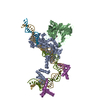 5zdzC 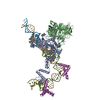 5ze0C  5ze1C  5ze2C  6cg0C  6cikC  6cilC  6cimC M: map data used to model this data C: citing same article ( |
|---|---|
| Similar structure data |
- Links
Links
- Assembly
Assembly
| Deposited unit | 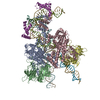
|
|---|---|
| 1 |
|
- Components
Components
-V(D)J recombination-activating protein ... , 2 types, 4 molecules ACDB
| #1: Protein | Mass: 88670.805 Da / Num. of mol.: 2 Source method: isolated from a genetically manipulated source Source: (gene. exp.)   Homo sapiens (human) Homo sapiens (human)References: UniProt: P15919, Hydrolases; Acting on ester bonds, RING-type E3 ubiquitin transferase #8: Protein | Mass: 58158.254 Da / Num. of mol.: 2 Source method: isolated from a genetically manipulated source Source: (gene. exp.)   Homo sapiens (human) / References: UniProt: P21784 Homo sapiens (human) / References: UniProt: P21784 |
|---|
-DNA chain , 6 types, 6 molecules FIJGLM
| #2: DNA chain | Mass: 14268.144 Da / Num. of mol.: 1 / Source method: obtained synthetically / Source: (synth.)  Homo sapiens (human) Homo sapiens (human) |
|---|---|
| #3: DNA chain | Mass: 4880.164 Da / Num. of mol.: 1 / Source method: obtained synthetically / Source: (synth.)  Homo sapiens (human) Homo sapiens (human) |
| #4: DNA chain | Mass: 6091.926 Da / Num. of mol.: 1 / Source method: obtained synthetically / Source: (synth.)  Homo sapiens (human) Homo sapiens (human) |
| #5: DNA chain | Mass: 18809.023 Da / Num. of mol.: 1 / Source method: obtained synthetically / Source: (synth.)  Homo sapiens (human) Homo sapiens (human) |
| #7: DNA chain | Mass: 9138.938 Da / Num. of mol.: 1 / Source method: obtained synthetically / Source: (synth.)  Homo sapiens (human) Homo sapiens (human) |
| #9: DNA chain | Mass: 12655.191 Da / Num. of mol.: 1 / Source method: obtained synthetically / Source: (synth.)  Homo sapiens (human) Homo sapiens (human) |
-Protein , 1 types, 1 molecules N
| #6: Protein | Mass: 18897.885 Da / Num. of mol.: 1 Source method: isolated from a genetically manipulated source Source: (gene. exp.)  Homo sapiens (human) / Gene: HMGB1, HMG1 / Production host: Homo sapiens (human) / Gene: HMGB1, HMG1 / Production host:  |
|---|
-Non-polymers , 2 types, 4 molecules 


| #10: Chemical | | #11: Chemical | |
|---|
-Experimental details
-Experiment
| Experiment | Method: ELECTRON MICROSCOPY |
|---|---|
| EM experiment | Aggregation state: PARTICLE / 3D reconstruction method: single particle reconstruction |
- Sample preparation
Sample preparation
| Component | Name: RAG1/2 in complex with nicked DNAs / Type: COMPLEX / Entity ID: #1-#9 / Source: RECOMBINANT |
|---|---|
| Source (natural) | Organism:  |
| Source (recombinant) | Organism:  Homo sapiens (human) Homo sapiens (human) |
| Buffer solution | pH: 7.4 |
| Specimen | Conc.: 0.3 mg/ml / Embedding applied: NO / Shadowing applied: NO / Staining applied: NO / Vitrification applied: YES |
| Vitrification | Cryogen name: ETHANE |
- Electron microscopy imaging
Electron microscopy imaging
| Experimental equipment |  Model: Titan Krios / Image courtesy: FEI Company |
|---|---|
| Microscopy | Model: FEI TITAN KRIOS |
| Electron gun | Electron source:  FIELD EMISSION GUN / Accelerating voltage: 300 kV / Illumination mode: FLOOD BEAM FIELD EMISSION GUN / Accelerating voltage: 300 kV / Illumination mode: FLOOD BEAM |
| Electron lens | Mode: BRIGHT FIELD |
| Image recording | Electron dose: 57.6 e/Å2 / Film or detector model: GATAN K2 SUMMIT (4k x 4k) |
- Processing
Processing
| Software | Name: PHENIX / Version: 1.12_2829: / Classification: refinement | ||||||||||||||||||||||||
|---|---|---|---|---|---|---|---|---|---|---|---|---|---|---|---|---|---|---|---|---|---|---|---|---|---|
| EM software | Name: RELION / Version: 2.1 / Category: 3D reconstruction | ||||||||||||||||||||||||
| CTF correction | Type: PHASE FLIPPING AND AMPLITUDE CORRECTION | ||||||||||||||||||||||||
| 3D reconstruction | Resolution: 3.9 Å / Resolution method: FSC 0.143 CUT-OFF / Num. of particles: 49624 / Symmetry type: POINT | ||||||||||||||||||||||||
| Atomic model building | Protocol: RIGID BODY FIT / Target criteria: Correlation Coefficient | ||||||||||||||||||||||||
| Refine LS restraints |
|
 Movie
Movie Controller
Controller


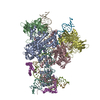
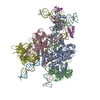
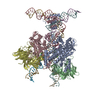

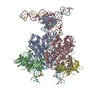


 PDBj
PDBj

























































